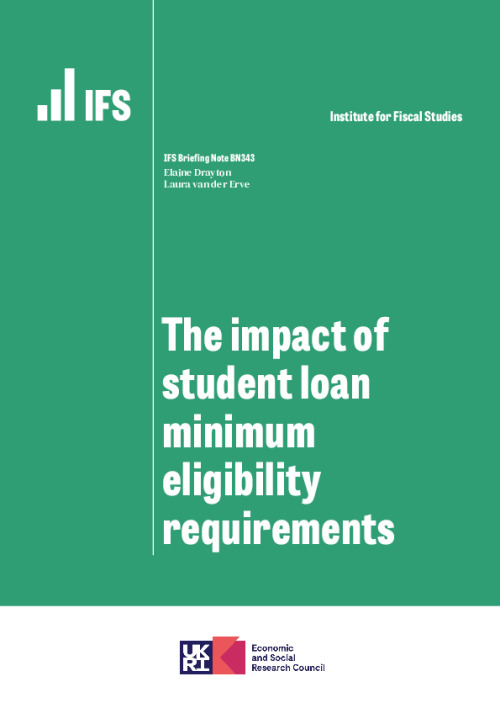In February 2022, the government announced reforms to the English higher education system as part of its long-awaited response to the 2019 Augar Review of post-16 education. In addition to introducing changes to the student loan system,[1] the government also opened a consultation on further changes to the system (Department for Education, 2022a), including on the introduction of a minimum eligibility requirement (MER) for access to student loans.
The two specific proposals being consulted on are to set this minimum eligibility requirement at having at least a 4/C grade in English and maths GCSEs, or to set this at two A levels (or equivalents) at grade E or above. Students who do not achieve these qualifications would not be eligible for student loans. Certain groups of students would be exempt from these proposals, such as those who fail the GCSE requirement but who go on to obtain ‘good’ A levels (i.e. at least three grade Cs), students above the age of 25, part-time students and students who have obtained Level 4 or Level 5 qualifications.
In this briefing note, we consider who would be affected by each of the proposed MERs, and then assess whether the introduction of an MER is likely to achieve the government’s stated aim of ensuring that ‘students undertaking degree study have attained the baseline skills required to engage with and benefit from the course’ (Department for Education, 2022a).
Our analysis focuses on individuals from the 2011 and 2012 GCSE cohorts who started a full-time undergraduate degree at age 18 or 19, as this allows us to observe their degree outcomes. Where possible, we highlight how the picture looks for more recent cohorts. We define pupils as having met the GCSE threshold if they are recorded in the National Pupil Database as having achieved A*–C (Level 2) in English and maths GCSE or equivalents between the ages of 15 and 16. Students are treated as meeting the A-level threshold if they obtained at least two A-level passes (grade E or above) or equivalent at KS5. Throughout, we use achieving passes in English and maths GCSE or at least two grades E or above at A level to mean achieving these thresholds, inclusive of equivalents.
Who will be affected?
Around 40% of pupils in the 2011 and 2012 GCSE cohorts did not achieve at least a grade 4/C in English and maths GCSEs, and a similar share did not achieve at least two grades E or above in A levels. This is very high internationally: in 2012, England had the third-highest share of young people with low (below Level 2) literacy and numeracy skills in the OECD (Kuczera, Field and Windisch, 2016). The shares of students without these basic qualifications have stayed relatively constant over time, except in the last two years when the introduction of teacher-assessed grades during the COVID-19 pandemic led to a significant uptick in grades (Department for Education, 2022b). If this uptick was temporary, we would expect the introduction of either of the two proposed MERs to restrict access to student loans for around 40% of school pupils. While these numbers seem large, in practice most of these individuals would not have been expected to go to university even in the absence of any restrictions on student loans. Only 9% of those without passes in maths and English GCSE go on to university. To determine who would be affected by the introduction of an MER, a more relevant measure is the share of students who attended university and who would not have been able to do so had an MER been in place.
Despite the two MERs affecting similar numbers of school pupils, there is a large difference in the share of university students who would be affected by each threshold. Amongst individuals from the 2011 and 2012 GCSE cohorts who attended university, around 10% did not achieve at least a grade 4/C in English and maths GCSE. Internationally, the share of undergraduates in England who lack basic numeracy and literacy skills is very high. Almost twice as many English university students lack these basic skills compared with the OECD average (Kuczera, Field and Windisch, 2016). Fewer people would have been affected by an A-level requirement – around 2% of those who attended university did not have at least two E grades at A level or equivalent. This difference is due to universities themselves typically having minimum entry requirements that are based on A-level grades – as a result, virtually none of those who pass the GCSE requirement but fail to obtain at least two Es at A level go to university. It is worth keeping in mind that if MERs were to be introduced, this would change students’ incentives, which might mean fewer students are affected. For example, if a GCSE minimum eligibility requirement were introduced, we would expect more students to resit their English and maths GCSEs, and consequently fewer of them to be ineligible for student loans.
Figure 1. Share of age 18–19 university entrants affected by GCSE and A-level MER, by socio-economic status and ethnicity
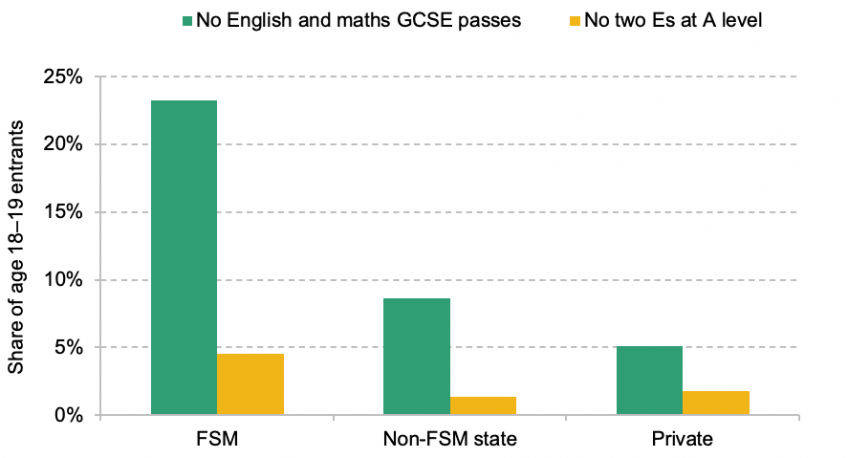
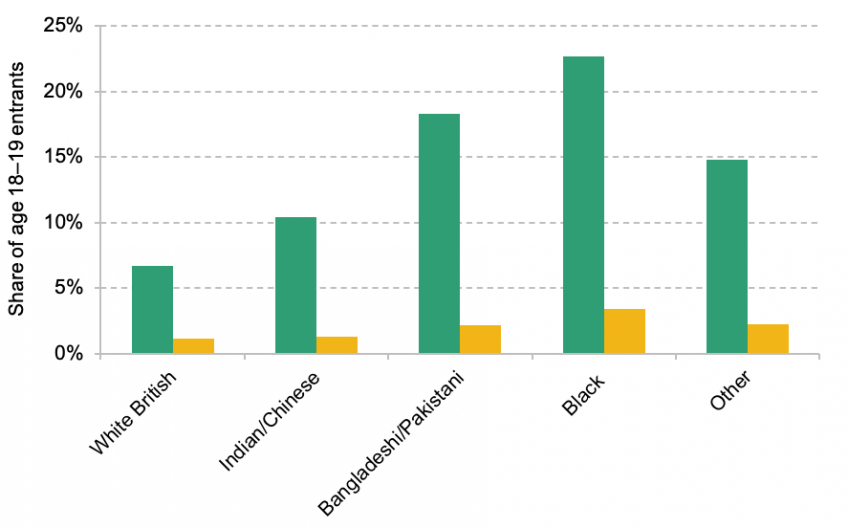
Note: Eligibility for free school meals (FSMs) is measured at age 16.
Due to large differences in educational attainment by ethnicity and socio-economic background, the share of university students who would be affected by the introduction of an MER varies considerably across these groups. Almost one in every four undergraduates who were eligible for free school meals (FSM) at age 16 – a marker of low family income – would not have been able to access student loans had a GCSE English and maths requirement been in place, compared with 9% of non-FSM state school students and only 5% of private school students (top panel of Figure 2.1). While these statistics relate to the 2011 and 2012 cohorts, there has been little progress since in narrowing the attainment gap between FSM and non-FSM (Department for Education, 2019), suggesting these statistics are still relevant for recent (pre-pandemic) cohorts. As attending university without student loans would presumably be very difficult for FSM students, introducing the GCSE restriction on student loans would likely increase the already large socio-economic gaps in higher education participation.
Similarly, we see large differences across ethnic groups (bottom panel of Figure 2.1). Around 7% of white British undergraduates from state schools would have been impacted by the GCSE English and maths requirement, and around 10% of Chinese and Indian students. In contrast, nearly one in five (18%) Bangladeshi and Pakistani students would have been affected, and nearly one in four (23%) black African and black Caribbean undergraduates. This is driven by ethnic minority pupils from these groups having much higher university attendance rates than their white counterparts despite similar age 16 attainment (Department for Education, 2022c and 2022d).
If instead of passes in English and maths GCSE, individuals are required to have at least two Es at A level to be eligible for student loans, the impact on socio-economic gaps in access to higher education would be much smaller. Although FSM and certain ethnic minority groups would still be disproportionately affected relative to other groups of undergraduates, far fewer students would be affected overall. For instance, only 5% of current FSM undergraduates would have been affected by the two Es requirement compared with 23% under a requirement of a pass in English and maths GCSE.
What are the outcomes of those affected?
The stated aim of the introduction of minimum eligibility requirements in the government consultation is to ‘ensure that students undertaking degree study have attained the baseline skills required to engage with and benefit from the course’ (Department for Education, 2022a). This is not an unreasonable aim. As we saw in the previous section, England performs poorly in international comparisons in terms of young people’s skills and it is a reasonable assumption that students without basic numeracy and literacy skills may get less out of a degree. A key question when assessing the potential impact of such a policy is then: ‘How do students who would be affected by an MER fare at university and in the labour market?’.
Figure 2. Share of age 18–19 university entrants graduating and achieving a ‘good’ degree, by prior attainment
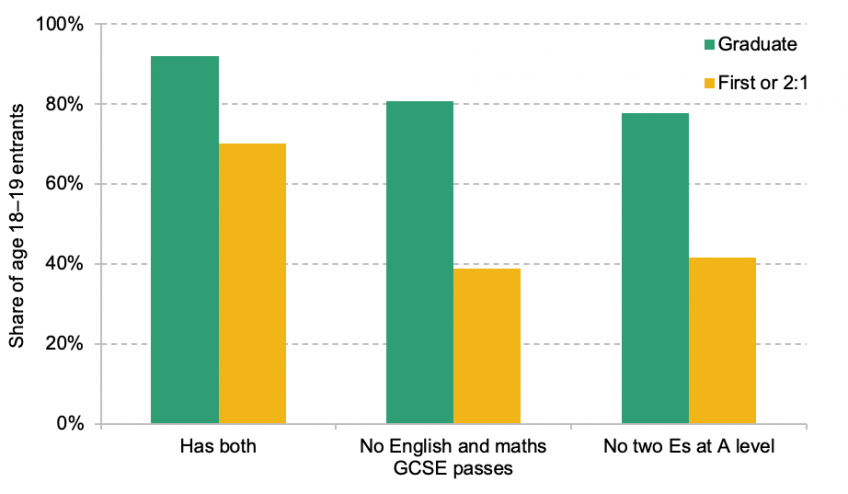
Undergraduates who do not meet the proposed GCSE or A-level requirements are just over 10 percentage points less likely to complete a degree than students meeting both thresholds (see Figure 3.1). Yet, the vast majority of these students (around 80%) do still graduate. In terms of degree classification, around 40% of those who did not achieve the GCSE and A-level thresholds obtained a first or 2:1 in their degree, compared with 70% of those who did achieve those thresholds, though research has shown that degree classification does not make a difference to future earnings for all subjects (Britton et al., 2022).
Clearly, those who would be affected by the proposed MERs perform considerably less well at university than their peers with higher prior attainment. Nevertheless, this policy would also exclude many who do seem able to ‘engage with and benefit from’ their degree, at least based on their performance at university.
Going beyond performance at university, we can also look at the earnings individuals achieve after graduation. Due to data availability, we draw on existing research to study this question, with the caveat that most of the evidence relates to students who have achieved at least five GCSEs at grades A*–C.
As we saw in Section 2, many of those affected by the MERs are students from low-income and ethnic minority backgrounds. These students do tend to have lower earnings than graduates from other backgrounds (Department for Education, 2018), but many derive considerable benefit from higher education, in particular as their outside options are so poor (Britton, Dearden and Waltmann, 2021). At the same time, not all degrees pay off. Belfield et al. (2018) showed that certain courses did not provide a measurable earnings benefit to their graduates. If the aim were to reduce the number of students on such courses, targeting individuals with low prior attainment seems to be a very blunt instrument. While low-selectivity courses have lower returns than average, many courses attended by lower-attaining students have decent average earnings returns, and vice versa. This is highlighted by Figure 3.2, which shows some of the subjects most affected by the introduction of the proposed GCSE English and maths MER.
The GCSE requirement would have excluded 22% of age 18–19 entrants to social work courses and around 15% of age 18–19 entrants to communications and creative arts courses – all subjects with very low earnings returns – from obtaining student loans, but it would also have excluded 17% of computer science and 13% of business entrants – both subjects with very high earnings returns (Belfield et al., 2018). On the other hand, some subjects with low earnings returns, such as history and languages, would be barely affected as only around 3% of students on these courses do not have at least a grade 4/C in English and maths GCSEs. Furthermore, some of the subjects with the highest shares of 18- and 19-year-old entrants affected, such as social work (22%) and education (9%), may not have very high earnings returns but have considerable social value. While many students in these fields are part-time or mature students (and would therefore be exempt from the MERs), these fields already struggle with staff shortages, and it seems unlikely the government would want to further reduce the number of students on these courses.
Figure 3. Share of age 18–19 university entrants affected by GCSE and A-level MER, by subject
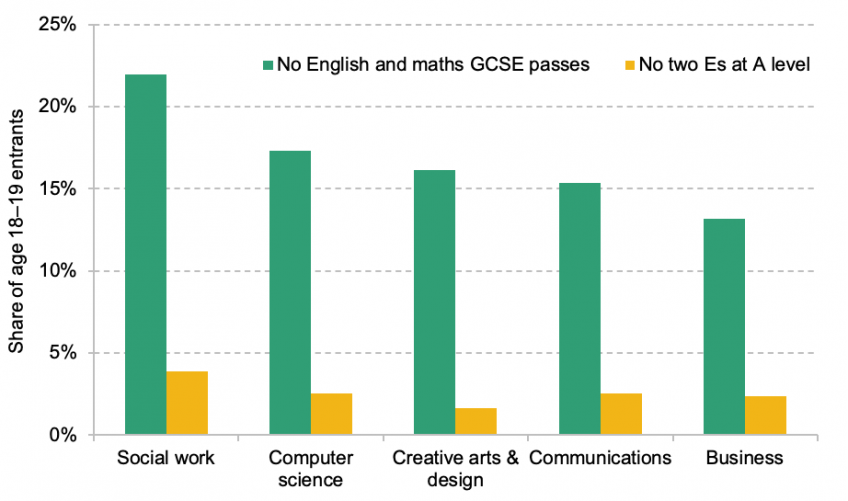
Discussion
A broader question surrounding this policy, and the wider package of measures proposed, is what it really aims to achieve. If the government’s aim is indeed to prevent students from going to university who not are not equipped to benefit from degree study, it is not clear that the MER proposed would achieve this – or at least it might do so but only at the cost of excluding many who would experience good degree outcomes. Additionally, unless it is set at such a low level as to affect virtually no one, a blanket MER would disproportionately affect groups of students who are already under-represented in higher education. This would be at odds with other government policy objectives to ensure equal access to higher education irrespective of student background.
One way to minimise these negative consequences would be to have contextualised MERs, as proposed by the Augar Review (2019). Under such a system, students from disadvantaged backgrounds would have lower minimum eligibility requirements than their peers, to acknowledge that these students have had fewer opportunities to succeed. The existing exemption for part-time students is already motivated by the fact that those choosing part-time study often do so because of personal circumstances (such as caring responsibilities) that are both barriers to full-time study and negatively impact prior attainment. A contextualised MER would apply this principle more equally across all students.
Alternatively, if the introduction of an MER results in stronger incentives for students and schools to reach the English and maths GCSE threshold and therefore in more students achieving basic English and maths skills, this would clearly be a very welcome outcome. Yet, despite the existing requirement for students in full-time post-16 education to continue studying English and maths if they have not achieved passes in these subjects, many still leave education without these basic qualifications. This suggests greater support throughout school to ensure all students leave education with basic levels of literacy and numeracy would be valuable.
If instead the government’s aim is to reduce the number of students on ‘low-value’ courses, targeting these courses more directly – for instance, by providing financial incentives for universities to provide courses with higher economic and social value – seems a more effective way to achieve this aim. Moreover, as we have shown, targeting students with low prior attainment could have important unintended consequences for the provision of courses such as social work and education which, though low-earning, are unlikely to be considered by the government as ‘low-value’.
[1] IFS responded to these by publishing Waltmann (2022).

